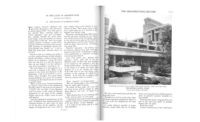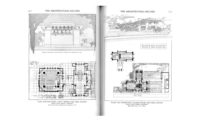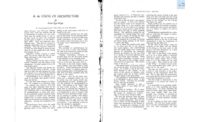Is it reasonable too to go further and say “sinews and bones”? Yes, but not as in the human frame but as a new world of form in themselves capable of being beautiful in themselves in a new sense, so devised in construction that flesh is unnecessary.
Why should not the structural principle be expressed artistically as well as scientifically for its own sake in this ideal material? Expressed with a knowledge of rhythm and synthesis of form that a master musician would bring to his mathematics? Can we not imagine a building to be serviceably beautiful and beautifully serviceable as it is naturally made – in steel? Glass is all that is needed really after we have honestly insured the life of the steel.
And, added to this immense possibility, here enters a vital modern probability:
Steel is most economical in tension; the steel strand is a marvel, let us say, as compared with anything scientists knew; a miracle of strength for its weight and cost. We have found now how to combine it with a mass material, concrete, which has great strength in compression. The co-efficient of expansion and contraction of both materials is the same in changes of temperature. The more bulky material protects the slighter material from its enemy, disintegration. The heavier material, or protector, strangely grows stronger as it grows older. Permanent “flesh” if we care to so regard it.
A valuable partnership in materials in any case more congenial to the architect than steel alone for he can do it more richly with flesh and sinews than he can with sinews and bones, perhaps. Certainly, if regarded as such by him.
Here we have reinforced concrete, a new dispensation. A new medium for the new world of thought and feeling that seems ideal: a new world that must follow freedom from the imprisonment in the abstract in which tradition binds us. Democracy means liberation from those abstractions, and therefore life, more abundantly in the concrete. This is not intended as a pun. It happens to be so literally, for concrete combined with steel strands will probably become the physical body of the modern civilized world.
Here again and especially has the machine liberated the creative architect.
And he prefers his bonds!
The old structural limitation that took form as masonry, lintels and arches, “natural” posts and beams, is all gone. There is in their place a science of mathematics applied to materials of marvelous new properties and strength, here to the architect’s hand instead – “mathematics materialized at work form man.”
What are we, as architects, going to do with it? For as yet, we have done nothing with it on principle. We have merely “made shift.” Architects have avoided an open break with the powers that be, on the ground of impotence, only by psalm singing and caroling in the name of tradition. But, enough.
Here in addition to the possibility of steel alone, is a perfect wedding of two plastic materials. A wondrous freedom! Freedom worthy of ideal democracy. Astounding! That upon so simple a means such a vast consequence to human life depends. But so it does. And just so simple has the initiation of far reaching changes brought by evolution always been.
The limitation of the human imagination is all that ties the hands of the modern architect except the poison in his veins fostered by “good taste” for dead forms.
His imagination now must devise the new cross sections for the machine more suitable for use in harmoniously framing steel. Rivets have interesting effects as well as facts. Steel plates have possibilities combining with posts and beams. And now there is electric welding to make the work more simple and integral. Posts may become beautiful, beams too. The principle of the “gusset” has a life of its own, still. Strangely, here is plastic material delivered by the Machine in any rigid structural form to be fastened together as members in a structural design.
The design may emphasize the plastic as structural or the structural as plastic. What that means in detail is a liberal education in itself. It must be had by the young architect. He will have to go to work at it himself.
And again, easier to comprehend are the new forms brought to hand by reinforced concrete.
First among them is the slab – next the cantilever – then the splay.
To be able to make waterproof, weatherproof slabs of almost any size or continuity is a great implication. A great means to a great end. To be able to make these slabs so they may support his tray on the fingers of his upraised arm, leads to another marvelous release, a new freedom.
This is the economic structural principle of the cantilever. A new stability as well as a new economy. The most romantic of all structural possibilities is here.
And last, there is the splay or sloping wall, used as a slide from wall into projections or from floors into walls or used in connection with the cantilever slab. It may be used as an expression of form in itself for protection or light. For economy it may be useful as support in both cases and enhance the plastic effect of the whole.
There is nothing in architecture ready made to meet those sweeping new “freedoms.”
What a release is here! The machine bought it in the ubiquitous ductile steel strand with its miraculous strength and the fortunate wedding of that strength with poured concrete.
What a circumstance!
Here, “young men in architecture,” is your palette. The “foyer” of your new world.
Let us of the former generation see you at work on it, in it for all you are worth.
And here again, the password is the word “plastic.” “Structuralities” as such must be forgotten. If you will take paper and fold it and bend it, or cardboard sheets and cut them and fit and arrange them into models for buildings, you will see the sense of the new structure in its primitive aspect. And then, after this superficial external view, get inside and make the whole line as one plastic entity – however the slabs tend to separate or fall to themselves.
And never lose sight of the fact that all in this new world is no longer in two dimensions. That was the old world.
We are capable of a world now in three dimensions; the third, as I have said before, interpreted as a spiritual matter that makes all integral – “at one.”
How life may be blessed by the release this simple development of its viewpoint will bring to mankind.
Paintings and sculpture for use to enrich and enhance the work, still live. They now live a detached life as things apparat, for and by themselves. It is a pity, for they can never thrive in that separate life.
Unfortunately, there is a conviction in certain quarters – if it amounts to a “conviction,” – chiefly European, - that ornamentation is untrue to the Machine in this, the Machine Age. That the use of ornamentation is a romanticism and therefore inappropriate.
The contrary is the case.
But it is true that ornamentation in the old sense as an “applied” thing, as something added to the thing superficially, however clearly adapted or “composed” is dead to this new world.
Ornamentation in the plastic sense* is as characteristic of the thing we call the machine as ornamentation in the old sense was a characteristic feature of “The Renaissance”; more so, because it is the imagination living in the process and so woven into the life of the thing. A matter of the “constitution” of the thing. The trace of human imagination as the poetic language of line and color must now live in the thing so far as it is natural to do it. And that is very far.
*This phase of the machine as the creative architect’s tool will be treated next as Fabrication and Imagination.







